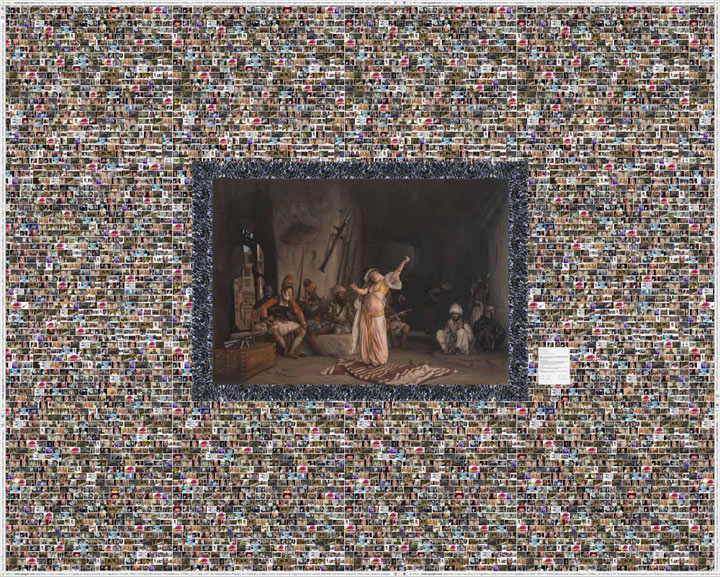JUAN FONTANIVE
12.7 x 9.4 x 10.1 cm. Mixed media and collage on Bristol paper, stainless steel, motor, and electronics.
JUAN FONTANIVE: Monday 20 February - Saturday 24 March
See-Sounds
installation film of four works in the ground floor gallery space
installation film of four works in the ground floor gallery space
Brooklyn-based Juan Fontanive's third solo exhibition at Riflemaker consists of a series of kinetic sculptures which move in sequence using metal linkages, rubber belts, pulleys and drives. The mechanisms are choreographed as individual elements working together like components in a song - each machine having its own sound crucial to the whole group. As with all of Fontanive's work, we're invited to look and listen.
Click to download book (PDF)
Click to download book (PDF)
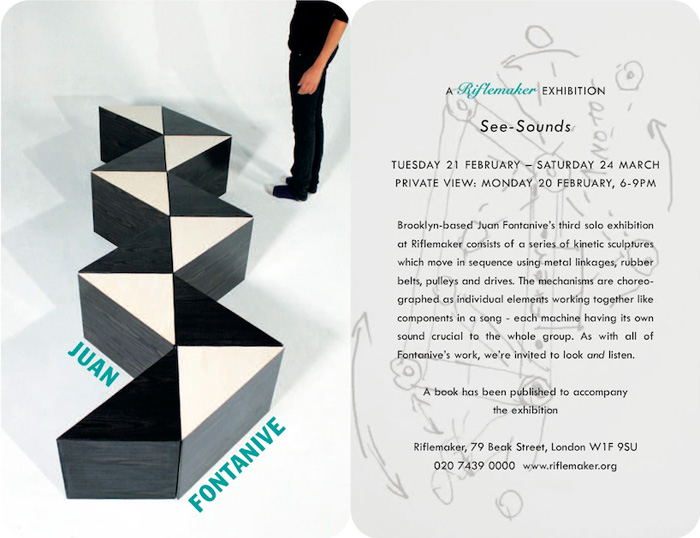
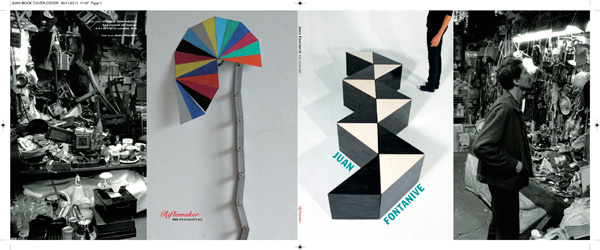
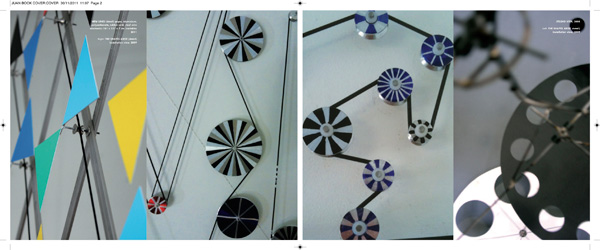
JUAN FONTANIVE (b. 1977, Cleveland, Ohio)
Juan Fontanive studied English and Textual Studies at Syracuse University, New York and Animation at The Royal College of Art, London.
He has presented two solo exhibitions 'Paper Films' (2006) and 'Tin Tan' (2008) at Riflemaker, London. Group exhibitions include 'For the Sake of the Image' (2010), Jerwood Space, London; 'Obsession': contemporary art from the Lodeveans Collection (2009), Stanley and Audrey Burton Gallery, Leeds; 'Indica' (2008) London and at Nyehaus, New York, and 'Ingenuity' (2007), The Gulbenkian Foundation, Lisbon (+ travelling exhibition of same). He won the Louise Wetherbee Phelps Award for Writing (1999) and the Desmond Preston Prize for Drawing (2004). He is represented by Riflemaker London and currently lives and works in Brooklyn, NY.
Juan Fontanive makes films without using light. Often recycling the mechanical parts of found clocks and pushbikes as the portable containers of his 'animations'. His interest lies in the beauty of sequential and repetitive movement. Hand drawn characters, human and typographical, occur in a cranky flip-book module powered by oxide. Pages fall in neat layers in the manner of a paper fountain, somewhere between film and sculpture - there is no 'screen' as such. His filmstock is often pulped card or metal leaves.
Juan Fontanive was born in 1977 in Cleveland Heights, Ohio. His family moved to Manhattan, New York and he attended Montessori schools. Juan's mother and sister are both painters and muralists that now work together. He often watched his mother at work in her studio, which inspired Juan to begin drawing. Another influence was his father's laboratory which contained jars filled with human organs, brains, an electron microscope, and other such things. His diagnosis of medical cases by analyzing cells under a microscope was similar, in a way, to the examination of individual frames of film. This shaped a large part of Juan's own attitude towards the moving image, which lies almost solely in the tedious, frame-by-frame handling found in animation.
In his undergraduate program, Juan made short 16mm films and combined them with interactive fiction, as part of a Liberal Arts degree in English and Textual Studies. Studying under an inspiring professor named Jeff Parker, he experimented with narrative using short fiction and flash fiction. H later continued these studies with Parker in Russia, and worked with contemporary poets and writers in St. Petersburg. These studies of broken/nonstandard narrative have led directly to the type of process he utilizes today.
"...I like to make things that dance..."
Fontanive's debut exhibition at Riflemaker consisted of a room of 'paper films'; mechanical flipbooks housed in tin cannisters reminiscent of an ammunitions factory clock or a 16mm cinema projector. These small modules, spools of paper attached to the wall or suspended on thin stalk-like legs, delivered a form of animated storytelling using revolving hand-drawn leaves of card and flickering Super 8 film.
An example of 'film without using light' as a projection source, the 'film' itself happens and exists inside of its own slightly cranky mechanism.
For 'Tin-Tan' Fontanive (b.1977 Cleveland, Ohio) has expanded both the physical scale and the illusionary aspect of the machines. The themes remain the same, sequential repetition of motion linked by a supposed and imagined narrative. The machines create natural 'shadows' and also have a uniquely comforting sound as the pages of paper or metal fall much like the turn of the film-sprocket of a hand-turned camera. There is comfort and an element of nostalgia in the resulting combination of both the rhythmic visual and sonic image.
"My influences include clocks, drums, repetition, things that hang from the ceiling. Physical quarrels, relationships (of objects), tigers, and the persistence of vision. Literary influences are Borges, Tolstoy, Chekhov, and the theorists Derrida and Althusser. Also, memory is a good source for ideas - I've been thinking recently a lot about the house I grew up in and dreams I've had about that house." Juan Fontanive.
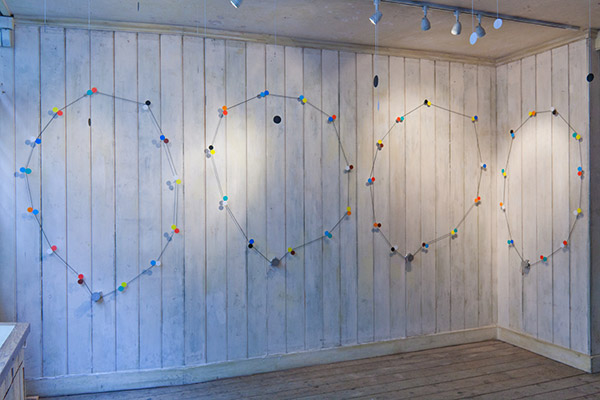
Installation view: Tabaré
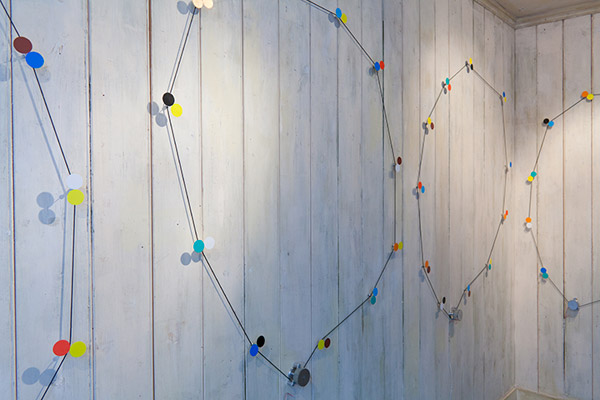
Installation view: Tabaré
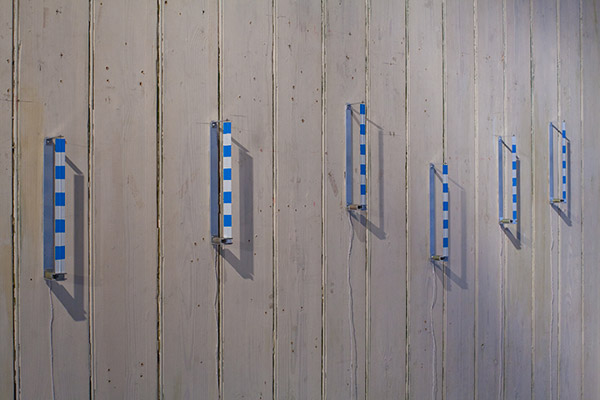
Installation view: Sounding Lines
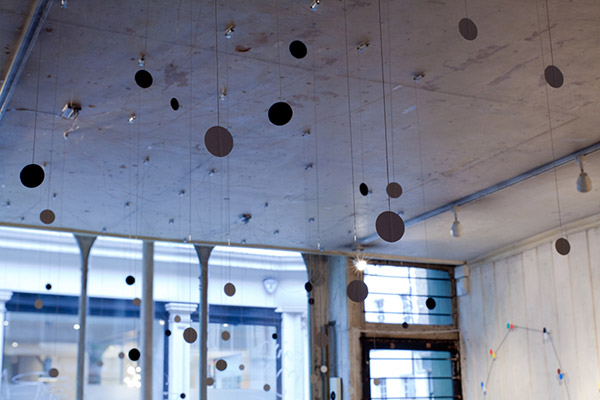
Installation view: Movement #2
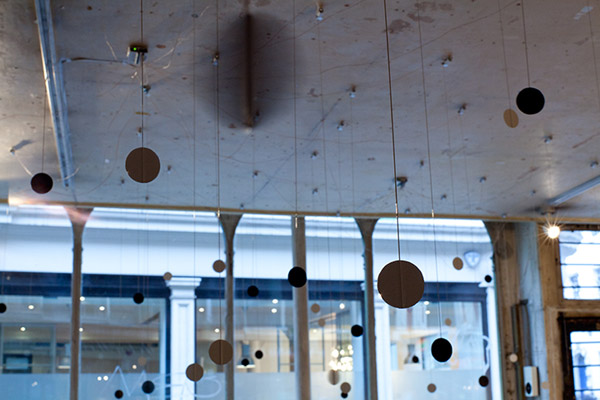
Installation view: Movement #2
'Movement 1'
Cord, piano-wire, paper, steel, brass, aluminum,
pulleys, electronics
3 x 3 x 2 m (2009)
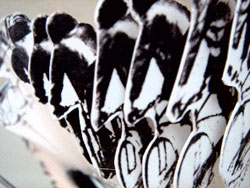 |
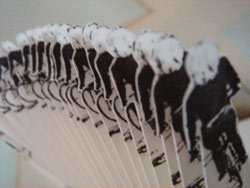 |
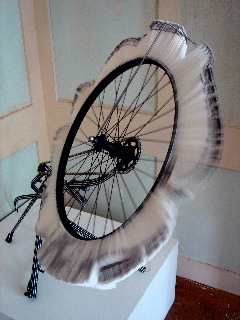 |
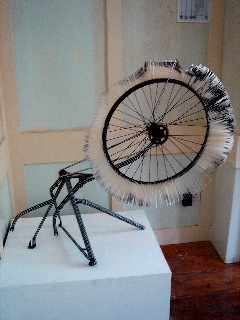 |
 |
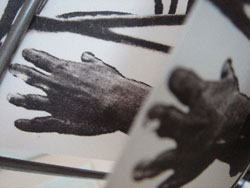 |
JUAN FONTANIVE (b. 1977, Cleveland, Ohio)
Juan Fontanive studied English and Textual Studies at Syracuse University, New York and Animation at The Royal College of Art, London.
He has presented two solo exhibitions 'Paper Films' (2006) and 'Tin Tan' (2008) at Riflemaker, London. Group exhibitions include 'For the Sake of the Image' (2010), Jerwood Space, London; 'Obsession': contemporary art from the Lodeveans Collection (2009), Stanley and Audrey Burton Gallery, Leeds; 'Indica' (2008) London and at Nyehaus, New York, and 'Ingenuity' (2007), The Gulbenkian Foundation, Lisbon (+ travelling exhibition of same). He won the Louise Wetherbee Phelps Award for Writing (1999) and the Desmond Preston Prize for Drawing (2004). He is represented by Riflemaker London and currently lives and works in Brooklyn, NY.
Juan Fontanive makes films without using light. Often recycling the mechanical parts of found clocks and pushbikes as the portable containers of his 'animations'. His interest lies in the beauty of sequential and repetitive movement. Hand drawn characters, human and typographical, occur in a cranky flip-book module powered by oxide. Pages fall in neat layers in the manner of a paper fountain, somewhere between film and sculpture - there is no 'screen' as such. His filmstock is often pulped card or metal leaves.
Juan Fontanive was born in 1977 in Cleveland Heights, Ohio. His family moved to Manhattan, New York and he attended Montessori schools. Juan's mother and sister are both painters and muralists that now work together. He often watched his mother at work in her studio, which inspired Juan to begin drawing. Another influence was his father's laboratory which contained jars filled with human organs, brains, an electron microscope, and other such things. His diagnosis of medical cases by analyzing cells under a microscope was similar, in a way, to the examination of individual frames of film. This shaped a large part of Juan's own attitude towards the moving image, which lies almost solely in the tedious, frame-by-frame handling found in animation.
In his undergraduate program, Juan made short 16mm films and combined them with interactive fiction, as part of a Liberal Arts degree in English and Textual Studies. Studying under an inspiring professor named Jeff Parker, he experimented with narrative using short fiction and flash fiction. H later continued these studies with Parker in Russia, and worked with contemporary poets and writers in St. Petersburg. These studies of broken/nonstandard narrative have led directly to the type of process he utilizes today.
"...I like to make things that dance..."
Fontanive's debut exhibition at Riflemaker consisted of a room of 'paper films'; mechanical flipbooks housed in tin cannisters reminiscent of an ammunitions factory clock or a 16mm cinema projector. These small modules, spools of paper attached to the wall or suspended on thin stalk-like legs, delivered a form of animated storytelling using revolving hand-drawn leaves of card and flickering Super 8 film.
An example of 'film without using light' as a projection source, the 'film' itself happens and exists inside of its own slightly cranky mechanism.
For 'Tin-Tan' Fontanive (b.1977 Cleveland, Ohio) has expanded both the physical scale and the illusionary aspect of the machines. The themes remain the same, sequential repetition of motion linked by a supposed and imagined narrative. The machines create natural 'shadows' and also have a uniquely comforting sound as the pages of paper or metal fall much like the turn of the film-sprocket of a hand-turned camera. There is comfort and an element of nostalgia in the resulting combination of both the rhythmic visual and sonic image.
"My influences include clocks, drums, repetition, things that hang from the ceiling. Physical quarrels, relationships (of objects), tigers, and the persistence of vision. Literary influences are Borges, Tolstoy, Chekhov, and the theorists Derrida and Althusser. Also, memory is a good source for ideas - I've been thinking recently a lot about the house I grew up in and dreams I've had about that house." Juan Fontanive.
Juan Fontanive studied English and Textual Studies at Syracuse University, New York and Animation at The Royal College of Art, London.
He has presented two solo exhibitions 'Paper Films' (2006) and 'Tin Tan' (2008) at Riflemaker, London. Group exhibitions include 'For the Sake of the Image' (2010), Jerwood Space, London; 'Obsession': contemporary art from the Lodeveans Collection (2009), Stanley and Audrey Burton Gallery, Leeds; 'Indica' (2008) London and at Nyehaus, New York, and 'Ingenuity' (2007), The Gulbenkian Foundation, Lisbon (+ travelling exhibition of same). He won the Louise Wetherbee Phelps Award for Writing (1999) and the Desmond Preston Prize for Drawing (2004). He is represented by Riflemaker London and currently lives and works in Brooklyn, NY.
Juan Fontanive makes films without using light. Often recycling the mechanical parts of found clocks and pushbikes as the portable containers of his 'animations'. His interest lies in the beauty of sequential and repetitive movement. Hand drawn characters, human and typographical, occur in a cranky flip-book module powered by oxide. Pages fall in neat layers in the manner of a paper fountain, somewhere between film and sculpture - there is no 'screen' as such. His filmstock is often pulped card or metal leaves.
Juan Fontanive was born in 1977 in Cleveland Heights, Ohio. His family moved to Manhattan, New York and he attended Montessori schools. Juan's mother and sister are both painters and muralists that now work together. He often watched his mother at work in her studio, which inspired Juan to begin drawing. Another influence was his father's laboratory which contained jars filled with human organs, brains, an electron microscope, and other such things. His diagnosis of medical cases by analyzing cells under a microscope was similar, in a way, to the examination of individual frames of film. This shaped a large part of Juan's own attitude towards the moving image, which lies almost solely in the tedious, frame-by-frame handling found in animation.
In his undergraduate program, Juan made short 16mm films and combined them with interactive fiction, as part of a Liberal Arts degree in English and Textual Studies. Studying under an inspiring professor named Jeff Parker, he experimented with narrative using short fiction and flash fiction. H later continued these studies with Parker in Russia, and worked with contemporary poets and writers in St. Petersburg. These studies of broken/nonstandard narrative have led directly to the type of process he utilizes today.
"...I like to make things that dance..."
Fontanive's debut exhibition at Riflemaker consisted of a room of 'paper films'; mechanical flipbooks housed in tin cannisters reminiscent of an ammunitions factory clock or a 16mm cinema projector. These small modules, spools of paper attached to the wall or suspended on thin stalk-like legs, delivered a form of animated storytelling using revolving hand-drawn leaves of card and flickering Super 8 film.
An example of 'film without using light' as a projection source, the 'film' itself happens and exists inside of its own slightly cranky mechanism.
For 'Tin-Tan' Fontanive (b.1977 Cleveland, Ohio) has expanded both the physical scale and the illusionary aspect of the machines. The themes remain the same, sequential repetition of motion linked by a supposed and imagined narrative. The machines create natural 'shadows' and also have a uniquely comforting sound as the pages of paper or metal fall much like the turn of the film-sprocket of a hand-turned camera. There is comfort and an element of nostalgia in the resulting combination of both the rhythmic visual and sonic image.
"My influences include clocks, drums, repetition, things that hang from the ceiling. Physical quarrels, relationships (of objects), tigers, and the persistence of vision. Literary influences are Borges, Tolstoy, Chekhov, and the theorists Derrida and Althusser. Also, memory is a good source for ideas - I've been thinking recently a lot about the house I grew up in and dreams I've had about that house." Juan Fontanive.
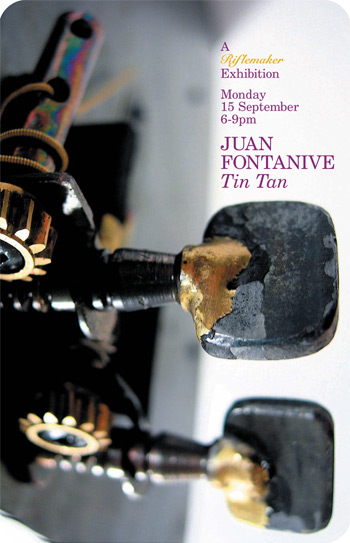
JUAN FONTANIVE
at Riflemaker 15 September - 8 November
"...I like to make things that dance"
Juan Fontanive's debut exhibition at Riflemaker consisted of a room of 'paper films'; mechanical flipbooks housed in tin cannisters reminiscent of an ammunitions factory clock or a 16mm cinema projector. These small modules, spools of paper attached to the wall or suspended on thin stalk-like legs delivered a form of animated storytelling using revolving hand-drawn leaves of card and flickering super 8 film.
An example of 'film without using light' as a projection source, the 'film' itself happens and exists inside of its own slightly cranky mechanism.
For 'Tin-Tan' Fontanive (b.1977 Cleveland, Ohio) has exapanded both the physical scale and the illusionary aspect of the machines. The themes remain the same, sequential repetition of motion linked by a supposed and imagined narrative. The machines create natural 'shadows' and also have a uniquely comforting sound as the pages of paper or metal fall much like the turn of the film-sprocket of a hand-turned camera. There is both comfort and an element of nostalgia in the resulting combination of both the rhythmic visual and sonic image.
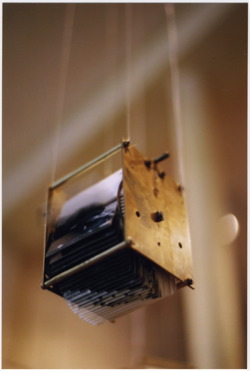
"My influences include clocks, drums, repetition, things that hang from the ceiling. Physical quarrels, relationships (of objects), tigers, and the persistence of vision. Literary influences are Borges, Tolstoy, Chekhov, and the theorists Derrida and Althusser. Also, memory is a good source for ideas - I've been thinking recently a lot about the house I grew up in and dreams I've had about that house."Juan Fontanive.
at Riflemaker 15 September - 8 November
"...I like to make things that dance"
Juan Fontanive's debut exhibition at Riflemaker consisted of a room of 'paper films'; mechanical flipbooks housed in tin cannisters reminiscent of an ammunitions factory clock or a 16mm cinema projector. These small modules, spools of paper attached to the wall or suspended on thin stalk-like legs delivered a form of animated storytelling using revolving hand-drawn leaves of card and flickering super 8 film.
An example of 'film without using light' as a projection source, the 'film' itself happens and exists inside of its own slightly cranky mechanism.
For 'Tin-Tan' Fontanive (b.1977 Cleveland, Ohio) has exapanded both the physical scale and the illusionary aspect of the machines. The themes remain the same, sequential repetition of motion linked by a supposed and imagined narrative. The machines create natural 'shadows' and also have a uniquely comforting sound as the pages of paper or metal fall much like the turn of the film-sprocket of a hand-turned camera. There is both comfort and an element of nostalgia in the resulting combination of both the rhythmic visual and sonic image.

"My influences include clocks, drums, repetition, things that hang from the ceiling. Physical quarrels, relationships (of objects), tigers, and the persistence of vision. Literary influences are Borges, Tolstoy, Chekhov, and the theorists Derrida and Althusser. Also, memory is a good source for ideas - I've been thinking recently a lot about the house I grew up in and dreams I've had about that house."Juan Fontanive.
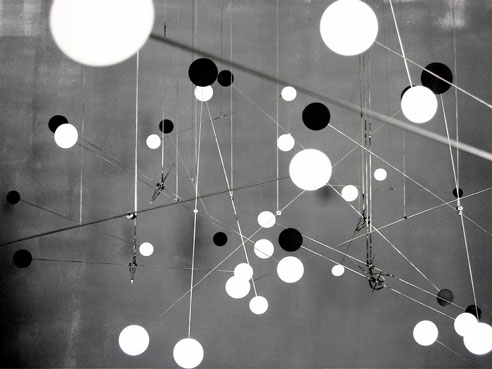
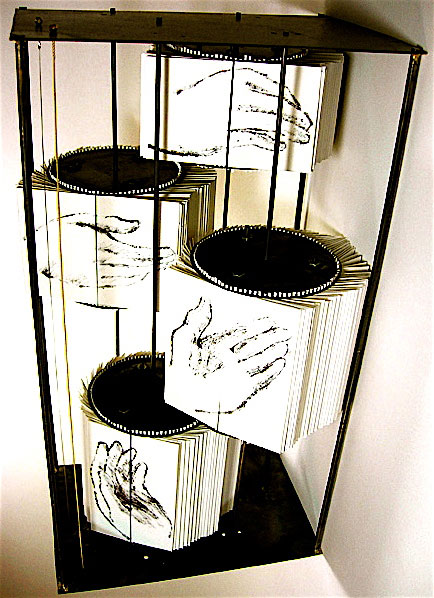
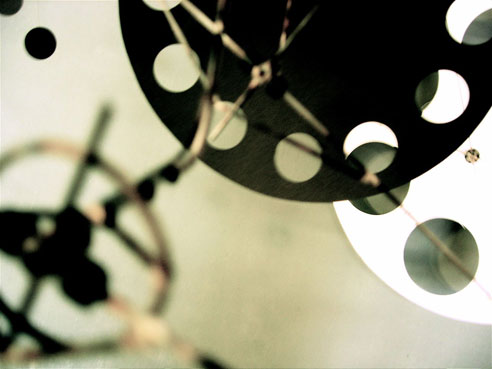
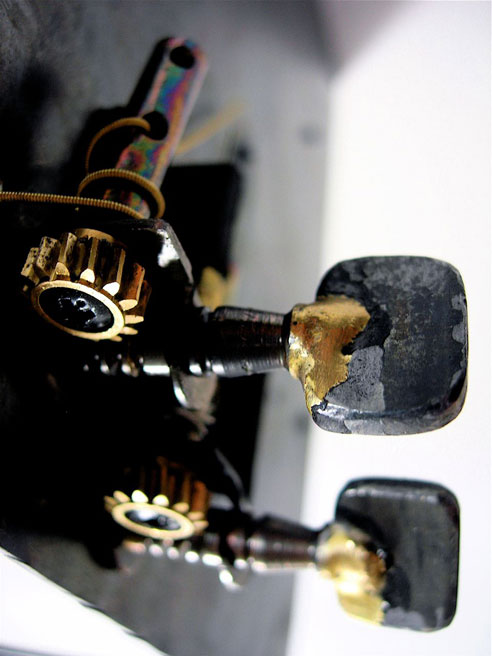
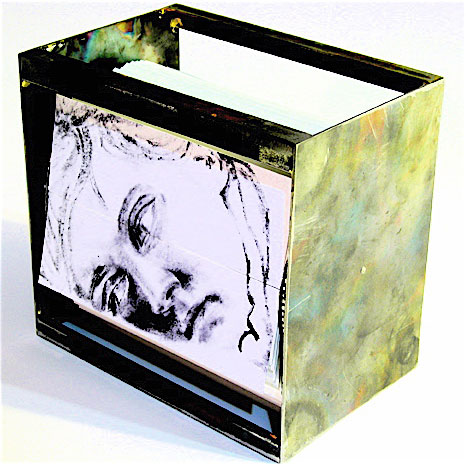
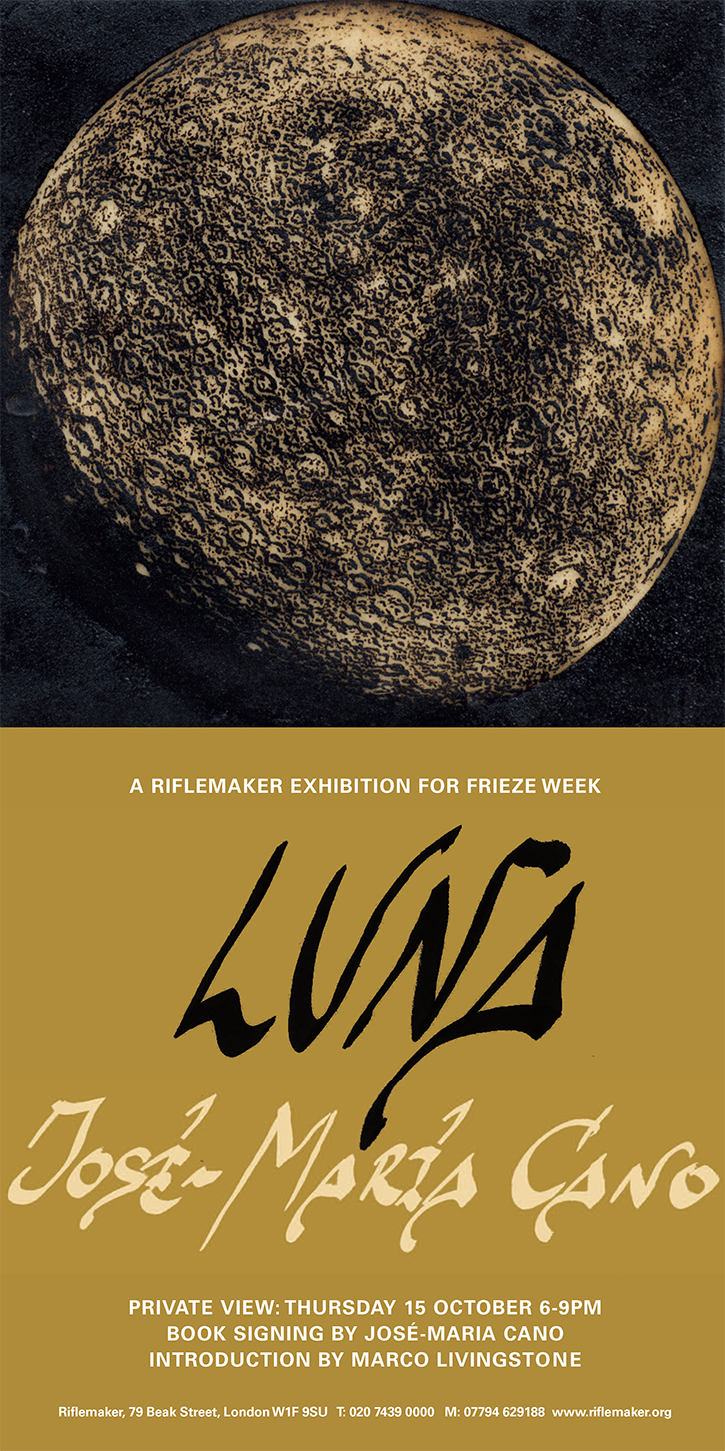
The next exhibition by JUDY CHICAGO will open at Riflemaker on Tuesday 15 September.
Riflemaker is pleased to announce that works by JUDY CHICAGO are also featured in
Tate Modern's 'The World Goes Pop' from 17 September 2015
and also in 'The Great Mother' at Fondazione Nicola Trussardi in Milan from 26 August 2015.
Riflemaker is pleased to announce that works by JUDY CHICAGO are also featured in
Tate Modern's 'The World Goes Pop' from 17 September 2015
and also in 'The Great Mother' at Fondazione Nicola Trussardi in Milan from 26 August 2015.
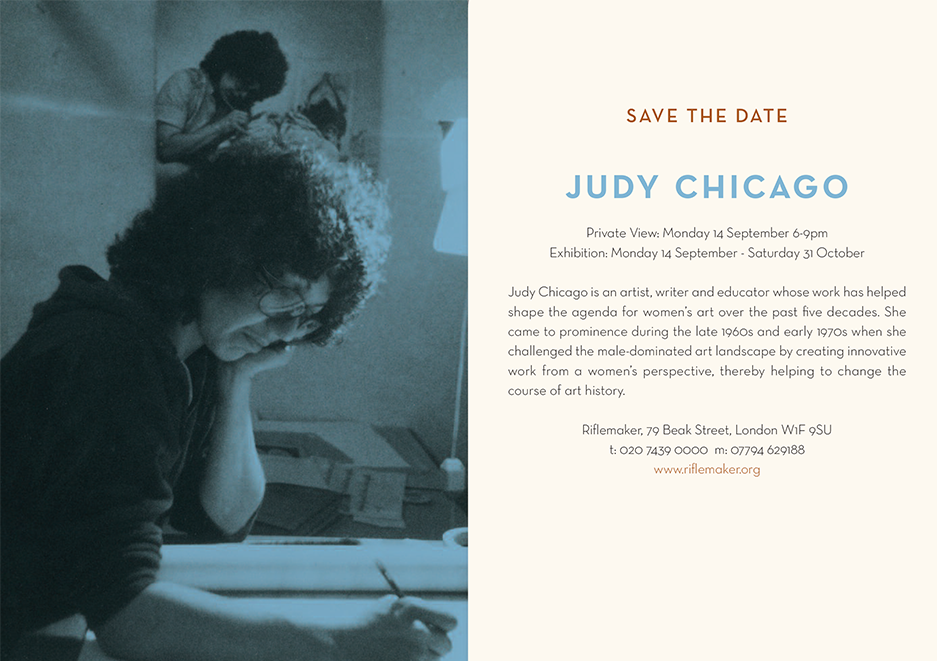
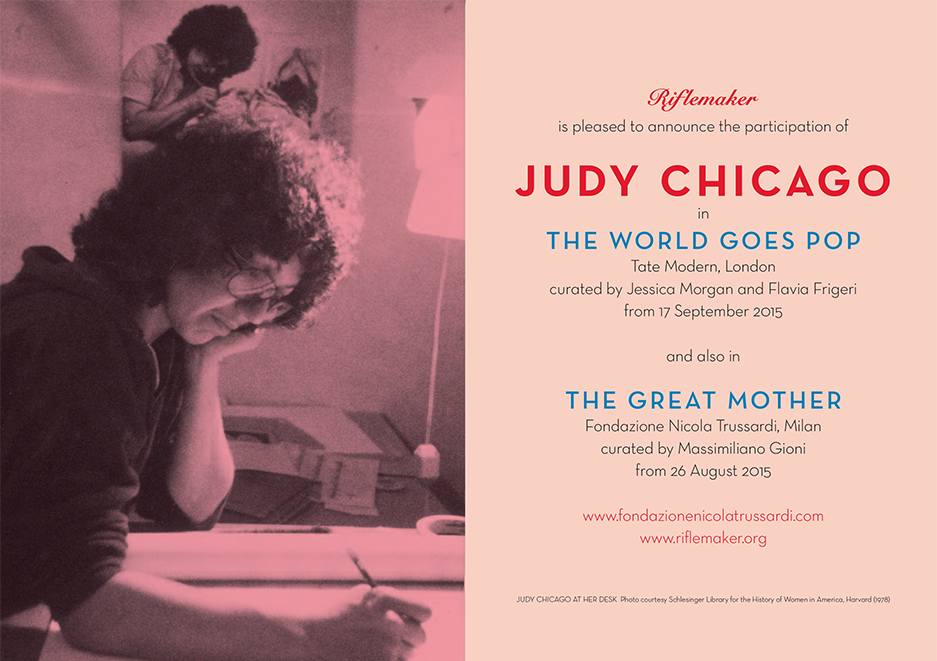
upcoming in early 2015 and previewing at the gallery now
WEN WU
WEN WU
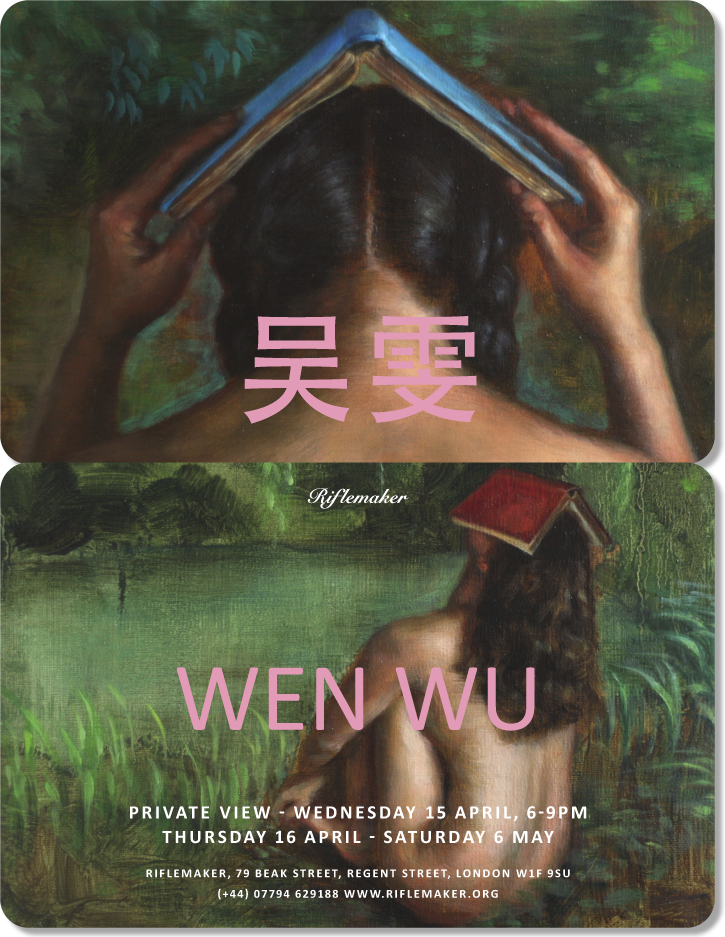
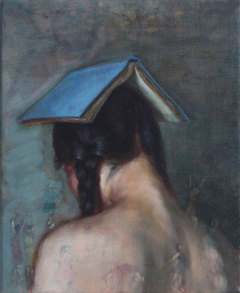

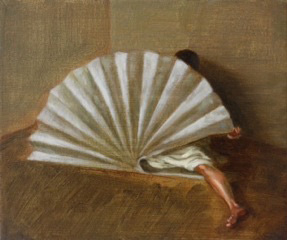
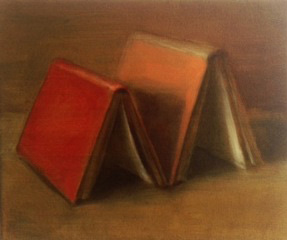
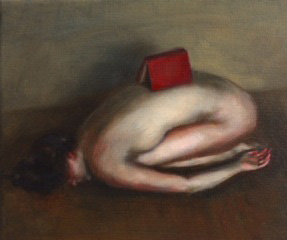
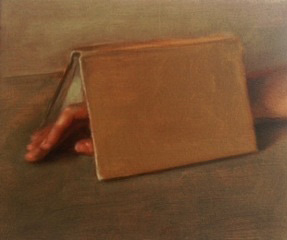
WEN WU
The Chinese painter Wen Wu (b. 1978 Qing Dao) graduated from Tsinghua University, Beijing, having been tutored by Chen Dan Qing, the most influential art educator in China.
Wu's paintings counter the commercialisation of art production in today's China, the sole aim of her canvases being aesthetic - primarily the representation of beauty. Her work breaks with the politically-orientated Social Realist style, popular from 1950-1970, toward a more poetic or 'literary' neo-realism taking its cue from Western sources, in her case everything from 19C French plein air romanticism through the English Pre-Raphaelites and the Victorian painters to the pre-WWII School of Paris.
In Chinese language systems, symbols or 'characters' depict the often monosyllabic words as pictograms or ideograms. Wen Wu takes the idea to its literal conclusion by using the physical shapes of these 'syllables' to present them as human figures. Two hardcover books placed side by side become 'Adam & Eve', a woman's body set within a paper fan is 'The Original Force of Creation'. A young girl's hand emerging from a folded edition becomes 'My Roving Desires'.
Each small painting is figurative though the spirit of the work appears abstract. Pools of colour almost consume the subject within a world of shadows. Ochre and cerise fill both background and foreground while the execution of the image, the instinctive brushstrokes, the body shapes and also the body language of the models within these tabletop objets have an indefinable nostalgic quality.
Wen Wu will exhibit the complete set of 40 book paintings at Riflemaker in March 2015.
images: each painting: oil on canvas, 30 x 26 cm (2014)
Reading:
Asia Society. Chronologies for Mainland China, Taiwan, and Hong Kong (1970)
Chu, Christina. 'Twentieth Century Chinese Painting: Tradition and Innovation' (1995)
Clunas, Craig. 'Chinese Art and Chinese Artists in France' (1924-25)
Doar, Bruce and Susan Dewar. "From Tradition to Modernity" Asia-Pacific Sculpture News, vol. 1, # 1 (Winter 1995)
The Chinese painter Wen Wu (b. 1978 Qing Dao) graduated from Tsinghua University, Beijing, having been tutored by Chen Dan Qing, the most influential art educator in China.
Wu's paintings counter the commercialisation of art production in today's China, the sole aim of her canvases being aesthetic - primarily the representation of beauty. Her work breaks with the politically-orientated Social Realist style, popular from 1950-1970, toward a more poetic or 'literary' neo-realism taking its cue from Western sources, in her case everything from 19C French plein air romanticism through the English Pre-Raphaelites and the Victorian painters to the pre-WWII School of Paris.
In Chinese language systems, symbols or 'characters' depict the often monosyllabic words as pictograms or ideograms. Wen Wu takes the idea to its literal conclusion by using the physical shapes of these 'syllables' to present them as human figures. Two hardcover books placed side by side become 'Adam & Eve', a woman's body set within a paper fan is 'The Original Force of Creation'. A young girl's hand emerging from a folded edition becomes 'My Roving Desires'.
Each small painting is figurative though the spirit of the work appears abstract. Pools of colour almost consume the subject within a world of shadows. Ochre and cerise fill both background and foreground while the execution of the image, the instinctive brushstrokes, the body shapes and also the body language of the models within these tabletop objets have an indefinable nostalgic quality.
Wen Wu will exhibit the complete set of 40 book paintings at Riflemaker in March 2015.
images: each painting: oil on canvas, 30 x 26 cm (2014)
Reading:
Asia Society. Chronologies for Mainland China, Taiwan, and Hong Kong (1970)
Chu, Christina. 'Twentieth Century Chinese Painting: Tradition and Innovation' (1995)
Clunas, Craig. 'Chinese Art and Chinese Artists in France' (1924-25)
Doar, Bruce and Susan Dewar. "From Tradition to Modernity" Asia-Pacific Sculpture News, vol. 1, # 1 (Winter 1995)
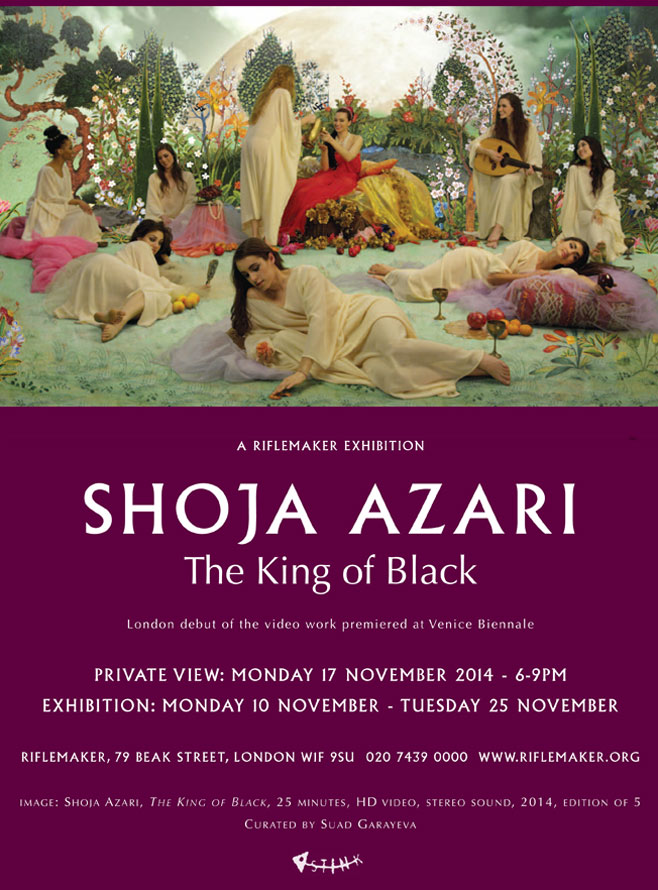
Click here for hi-res image
SHOJA AZARI (Iranian, b. 1958)
THE KING OF BLACK
HD colour video, 24 minutes, stereo sound (2013)
Shoja Azari is a visual artist/filmmaker who combines film with painting and photography. Since 1998, Azari and Shirin Neshat have developed a unique collaboration producing film and art installations together which have received international acclaim. Turbulent was the recipient of the Golden Lion at Venice in 1998. The work Women Without Men (2010), a feature written and directed with Neshat, was the winner of the Silver Lion at Venice. Based on the controversial novel by Shahrnoush Parsipour, the film interweaves the lives of four Iranian women during the summer of 1953 - a pivotal moment in Iranian history during an American led coup. Shoja Azari (b. 1958) lives and works in New York City.
Azari's short film merges live action filmmaking with miniature painting. 'The King of Black' is based on a 12th century illustrated poem, Haft Paykar (The Seven Beauties) completed by the Azerbaijani poet Nizami in 1197. In the tale, the king visits one of his seven brides, each residing in a different coloured dome on successive days of the week. The brides weave their own an elaborate stories of intrigue and morality, ultimately transforming the king into a 'just' ruler. Azari's film explores the allegory related by the Princess in the Black Dome, the one which emphasises the value of patience.
The king searches for the secret meaning behind a city's perpetual mourning and black dress. After one year of searching he is directed to a garden of paradise where he indulges in earthly pleasures for thirty days and thirty nights, yet is consistently denied the affections of the queen of the heavenly realm. Despite her council of endurance the king is impatient. Unable to endure the wait any longer he is returned to earth to forever lament the loss of utopia. Azari's film, and Nizami's poem, meditate on the notion of paradise and the patience required to achieve the promise of heaven.
In order to realise the complex relationship between paradise and patience, the film establishes a visual and ideological dialectic. The lush setting of the manipulated miniature paintings is realised in the presence of the austerely attired characters. The opulence of the visual narrative provides a counterpoint to the tale of patience and endurance. Within the film's theatrical tension is also a tale which is as relevant today as it was almost a millennium ago.
At the heart of the narrative is the treatise that that neither perfection nor paradise can be achieved so long as the individual is tied to the earthly delights of greed and lust. For the artist and the film, promises of earthly pleasures in heaven - which can both delude and manipulate - undermine the philosophical depth of one's triumph over desire and the patience and endurance required to reach such a point.
- adapted from the exhibition catalogue for 'LOVE ME, LOVE ME NOT', published by YARAT on the occasion of the collateral event of the 53rd Biennale de Venezia. Producer: YARAT, curator: Dina Nasser-Khadavi.
We are grateful to StinkDigital in London for their presentation and support of this project: www.stinkdigital.com
-----------------------------------------------------------------------------------------
SHOJA AZARI
Banquette of Houries (from The King of Black) 2013
inkjet print ed. 5
30 x 41.5 in / 76 x 105 cm
Banquette of Houries (from The King of Black) 2013
inkjet print ed. 5
30 x 41.5 in / 76 x 105 cm
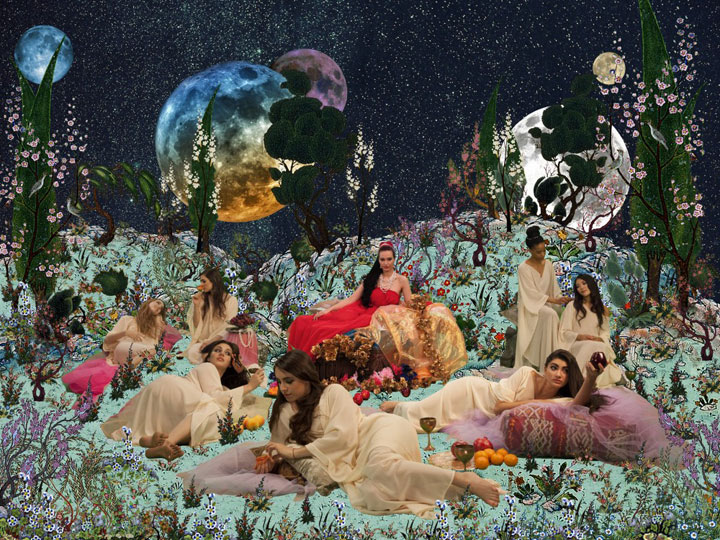
SHOJA AZARI
The Heavenly Bed (from The King of Black) 2013
inkjet print ed. 5
30 x 41.5 in / 76 x 105.41 cm
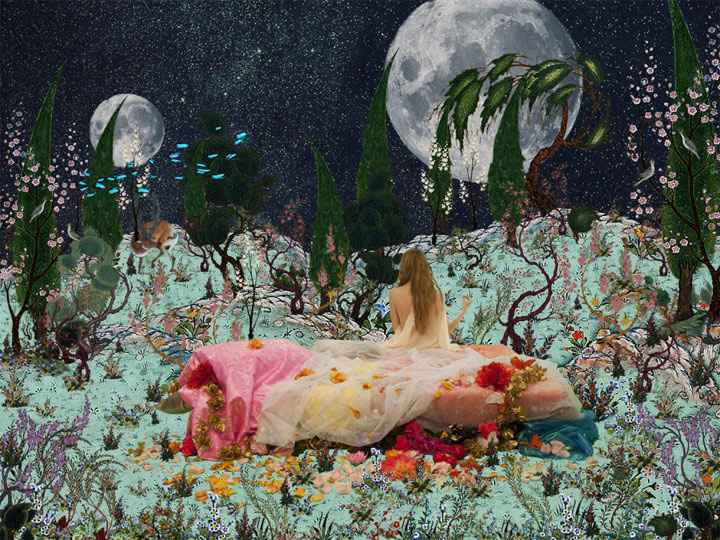
SHOJA AZARI
The Dance of Alema or The Ugly Hamza 2013
oil on canvas
58 x 40 in / 147.3 x 101 cm
